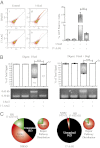BRCA1 and HSP90 cooperate in homologous and non-homologous DNA double-strand-break repair and G2/M checkpoint activation
- PMID: 22869732
- PMCID: PMC3427093
- DOI: 10.1073/pnas.1203326109
BRCA1 and HSP90 cooperate in homologous and non-homologous DNA double-strand-break repair and G2/M checkpoint activation
Abstract
Expression of functional breast cancer susceptibility gene 1 (BRCA1) in human breast and ovarian cancers is associated with resistance to platinum-based chemotherapeutics and poly(ADP ribose) polymerase (PARP) inhibitors. BRCA1 is a nuclear tumor suppressor that is critical for resolving double-strand DNA breaks (DSBs) and interstrand crosslinks (ICLs) by homologous recombination (HR). In vitro, animal and human clinical data have demonstrated that BRCA1-deficient cancers are highly sensitive to ICL-inducing chemotherapeutic agents, are amenable to synthetic lethal approaches that exploit defects in DSB/ICL repair, and may be associated with improved survival. Conversely, high or restored expression of BRCA1 in breast and ovarian cancer is associated with therapeutic resistance and poor prognosis. There has been much interest in identifying agents that interfere with BRCA1-dependent DSB/ICL repair to restore or enhance sensitivity to cancer therapeutics. We demonstrate that the heat-shock protein 90 (HSP90) inhibitor 17-allylamino-17-demethoxygeldanamycin [17-AAG (Tanespimycin)], currently in Phase II/III clinical evaluation for several cancers, induces BRCA1 ubiquitination and proteasomal degradation, resulting in compromised repair of ionizing radiation- and platinum-induced DNA damage. We show that loss of HSP90 function abolishes BRCA1-dependent DSB repair and that BRCA1-deficient cells are hypersensitive to 17-AAG due to impaired Gap 2/Mitosis (G2/M) checkpoint activation and resultant mitotic catastrophe. In summary, we document an upstream HSP90-dependent regulatory point in the Fanconi anemia/BRCA DSB/ICL repair pathway, illuminate the role of BRCA1 in regulating damage-associated checkpoint and repair responses to HSP90 inhibitors, and identify BRCA1 as a clinically relevant target for enhancing sensitivity in refractory and/or resistant malignancies.
Conflict of interest statement
The authors declare no conflict of interest.
Figures




Similar articles
-
Stabilization of mutant BRCA1 protein confers PARP inhibitor and platinum resistance.Proc Natl Acad Sci U S A. 2013 Oct 15;110(42):17041-6. doi: 10.1073/pnas.1305170110. Epub 2013 Oct 1. Proc Natl Acad Sci U S A. 2013. PMID: 24085845 Free PMC article.
-
Hsp90α regulates ATM and NBN functions in sensing and repair of DNA double-strand breaks.FEBS J. 2017 Aug;284(15):2378-2395. doi: 10.1111/febs.14145. Epub 2017 Jul 9. FEBS J. 2017. PMID: 28631426
-
Ganetespib overcomes resistance to PARP inhibitors in breast cancer by targeting core proteins in the DNA repair machinery.Invest New Drugs. 2017 Jun;35(3):251-259. doi: 10.1007/s10637-016-0424-x. Epub 2017 Jan 23. Invest New Drugs. 2017. PMID: 28111726
-
Therapeutic exploitation of tumor cell defects in homologous recombination.Anticancer Agents Med Chem. 2008 May;8(4):448-60. doi: 10.2174/187152008784220267. Anticancer Agents Med Chem. 2008. PMID: 18473729 Review.
-
Crosstalk of DNA double-strand break repair pathways in poly(ADP-ribose) polymerase inhibitor treatment of breast cancer susceptibility gene 1/2-mutated cancer.Cancer Sci. 2018 Apr;109(4):893-899. doi: 10.1111/cas.13530. Epub 2018 Mar 6. Cancer Sci. 2018. PMID: 29427345 Free PMC article. Review.
Cited by
-
Hsp90 inhibitors are efficacious against Kaposi Sarcoma by enhancing the degradation of the essential viral gene LANA, of the viral co-receptor EphA2 as well as other client proteins.PLoS Pathog. 2012;8(11):e1003048. doi: 10.1371/journal.ppat.1003048. Epub 2012 Nov 29. PLoS Pathog. 2012. PMID: 23209418 Free PMC article.
-
PARP Inhibitor Resistance Mechanisms and Implications for Post-Progression Combination Therapies.Cancers (Basel). 2020 Jul 25;12(8):2054. doi: 10.3390/cancers12082054. Cancers (Basel). 2020. PMID: 32722408 Free PMC article. Review.
-
ATF6 prevents DNA damage and cell death in colon cancer cells undergoing ER stress.Cell Death Discov. 2022 Jun 25;8(1):295. doi: 10.1038/s41420-022-01085-3. Cell Death Discov. 2022. PMID: 35752616 Free PMC article.
-
The Role of Hsp90-R2TP in Macromolecular Complex Assembly and Stabilization.Biomolecules. 2022 Jul 28;12(8):1045. doi: 10.3390/biom12081045. Biomolecules. 2022. PMID: 36008939 Free PMC article. Review.
-
Homologous Recombination Deficiency in Ovarian, Breast, Colorectal, Pancreatic, Non-Small Cell Lung and Prostate Cancers, and the Mechanisms of Resistance to PARP Inhibitors.Front Oncol. 2022 Jun 17;12:880643. doi: 10.3389/fonc.2022.880643. eCollection 2022. Front Oncol. 2022. PMID: 35785170 Free PMC article. Review.
References
-
- Ford D, Easton DF, Bishop DT, Narod SA, Goldgar DE. Breast Cancer Linkage Consortium Risks of cancer in BRCA1-mutation carriers. Lancet. 1994;343:692–695. - PubMed
-
- King MC, Marks JH, Mandell JB. New York Breast Cancer Study Group Breast and ovarian cancer risks due to inherited mutations in BRCA1 and BRCA2. Science. 2003;302:643–646. - PubMed
-
- Thompson ME, Jensen RA, Obermiller PS, Page DL, Holt JT. Decreased expression of BRCA1 accelerates growth and is often present during sporadic breast cancer progression. Nat Genet. 1995;9:444–450. - PubMed
-
- Hall JM, et al. Linkage of early-onset familial breast cancer to chromosome 17q21. Science. 1990;250:1684–1689. - PubMed
-
- Friedman LS, et al. Confirmation of BRCA1 by analysis of germline mutations linked to breast and ovarian cancer in ten families. Nat Genet. 1994;8:399–404. - PubMed
Publication types
MeSH terms
Substances
Grants and funding
LinkOut - more resources
Full Text Sources
Other Literature Sources
Miscellaneous

